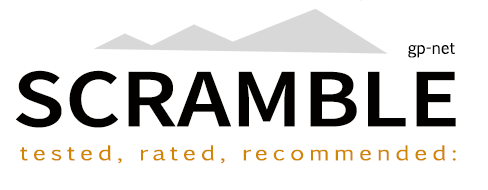Decathlon's Quechua Trek 500 Down Gilet
Preface
As always, we're looking at the Decathlon Trek 500 Down Gilet from the point of view of long distance trekking over tough terrain.
Test subject: Chest 42", Waist 33", Height: 5ft 8"
Test item: Size = Large
Kit Tests: Winter, Summer
Disclaimer: None required (item not provided by manufacturer)
Datasheet
| Materials (Outer / Lining): 15D Polyamide / Nylon 35gsm | 100% |
| Down Type (Down to Feather Ratio): Grey Duck | 85:15 |
| Fill Power (Cubic Inches): | 800 |
| Fil Weight (Large): | 91g |
| Weight (Size Large, measured / stated) | 216g / 220g |
| Product Sizing Reference: 42" Chest = | Large (slim fit) |
| Manufacturer RRP | £34.99 |
Scramble Review
Introduction: Fine Tuning Your Insulation
The two main insulation pieces Scramble recommend (one medium-weight and one light-weight), when used in combination, will handle winter temperatures down to around -20°C, with a total of 200 g/sm of Primaloft Gold insulation at the core. Used independently, the two jacket will easily handle the remaining seasons (certainly in the UK).
A down gilet, though not an absolute necessity, is a very handy accompaniment, enabling the wearer to fine tune their insulation requirements for each trip. When used in combination with both jackets you can extend -20°C to at least -30°C. But more useful is the gram shedding potential. For example, the down gilet under review here (L = 216g), combined with the lightweight Compressor Jacket (L = 380g) might replace the Keela Belay (M = 705g) for an early spring trek - shaving 109g off your total pack weight.
At Scramble we like down, but not as an outer layer, especially for northern European conditions where cold and wet often combine (saturated down loses 90% of its insulation, which can be dangerous if relied upon as a primary source in non-arid conditions). However, down works very well underneath synthetic insulation as a lightweight booster layer. We've had great results from our sleeping bag combination, where we do pretty much the same thing - using an ultralight down bag inside a synthetic outer bag - which has the added bonus of additional windproofing as well as creating a kind of double glazing effect.
Down gilets can be off-puttingly expensive, but Decathlon's Trek 500 Down Gilet is incredibly good value and comes with a highly competitive spec (see comparison below) which belies its price - something of a giant killer in this regard.
At 216g (size L) Decathlon's Trek 500 weighs less than many winter-weight baselayers (Helly's Warm Freeze and Bergans' Akeleie Half Zip both weigh around 250g).
Before we look at how this down gilet stacks up, a brief reminder of the various down specifications and what they're indicating:
Down With Specs
Fill Power
Fill power measures the degree of loft, which is an indication of the quality of the down; the more loft, the more trapped air, the greater the insulation. The fill power rating value is calculated by measuring how many cubic inches an ounce of down creates at its maximum loft. A down fill rating of 800, for example, means that one ounce of down can cover 800 cubic inches.
Down to Feather Ratio
This is simply a measure of how much of the insulation is actual down and how much is padded with feathers. The first number represents the percentage of down, the second, the percentage of feathers. The greater the proportion of down (the first number) the better the insulation.
Fill Weights
This is the total weight of down in the actual product.
It's sometimes hard to compare fill weights since often manufacturers quote for different sizes (Decathlon for example quote their L size = 91g, whereas Mountain Equipment use 71g for their Large and Montane state 95g but neglect to mention for which size). So it's hard to compare, but clearly it looks below, like the Decathlon and Montane products are very similar and the ME Arete uses less down and is likely a little less warm.
Competition Time
Below is Decathlon's Trek 500 and two of its closest big mountain brand competitors. You'll notice that their designs are almost identical, so how do they differ?
The Decathlon vest has a greater fill power, but has a little more feather in the mix which means slightly lower quality - but not much lower. Overall, the higher loft will likely compensate.
In terms of their specs, these down gilets are very much on a par. The big difference is their prices; the small difference is their weights, but impressively the Decathlon model wins on both. It's a lot cheaper, it's a little lighter and, in terms of its specs, is highly competitive.
The Montane and Mountain Equipments products (pictured above) are better finished as you'd expect, but again it's marginal. And for this kind of product, when used as an insulation boosting mid-layer for static use, it's not going to get bashed around. I've been using mine for a couple of years now and nothing so far has given me cause for concern.
In Use
On the last 8 day winter kit test (Feb 2018), I left behind a spare baselayer and packed the down gilet instead. This allowed me to always have an absolutely dry insulation combo of the Decathlon Gilet and the Keela Belay to get into once pitched and protected from the wind (lowest temp measured -11°C), while the Mountain Equipment synthetic jacket was used as a belay piece, taking the brunt of the wild weather during brief stops on the peaks where the windchill pushed temperatures below -20°C.
 Not recommended as an outer (left), but highly recommended under a quality synthetic outer like ME's Compressor (right)
Not recommended as an outer (left), but highly recommended under a quality synthetic outer like ME's Compressor (right)
The Trek 500 Down Gilet is close fitting, comfortable and impressively warm. There's not much going on with these down vests which helps keep the weight to a minimum. As for Decathlon's, it boasts two side pockets, packs up into the left one, and has a single elasticated adjuster to seal in the warmth at the hip. The pocket and front zips work fine without winning any awards for zip perfection (that currently goes to ME's Compressor).
In terms of sizing, I'm a 42" chest, 33" waist and generally a size large for UK and European brands. With a winter baselayer underneath, the large fits but only just - it's an ideal snug fit. Add an inch to both of those numbers above and I'd be an XL. So if you're on the margins, I'd recommend sizing up.
Any Negatives?
As previously stated, there's no doubt that Rab, Montane, Mountain Equipment et al offer versions with slightly better finishing, slightly better materials. But these advantages are marginal, yet when you combine, spec, performance and stunning value, the Decathlon Trek 500 is in a different league.
We've not found anything yet to complain about - we'll update this review if we do.
Conclusion & Rating
A down gilet is a very useful accompaniment to ones thermal arsenal, both for fine tuning insulation requirements for specific conditions or for simply extending your range into lower sub zero temperatures.
Decathlon's Quecha Trek 500 Down Gilet is a minimalist down vest with an excellent warmth to weight ratio that excels as a mid-layer beneath water-resistant synthetic insulation pieces. Weighing less than most winter-weight baselayers, the Trek 500 provides an impressive boost to your core warmth and helps fine tune your insulation requirements for any given trip. With a spec that competes well with many offerings from the best mountain brands, the Quecha Trek 500 is available at a fraction of the price - a true giant killer and our top pick in the Down Gilet (Thermal Booster Layer) category.
Product Images
Rating (out of 10)
* The value score is derived from two factors:
1) Competitive Market Price (CMP). This represents our judgement of a competitive online price point if we were to stock the item. e.g. if we feel we would need to sell an item at 40% off (i.e. 60% of its full RRP) to be competitive, then our CMP score will be 6/10.
2) Customer Value Price (CVP). We then make an honest appraisal of the maximum price we would be willing to pay for the item (and we're mean). So if we'd pay 80% of its RRP our CVP score would be 8/10.
We then average the two scores to get our final value score, which in our example would be 7/10.
Last Updated: 15/04/20 (new main image)

















